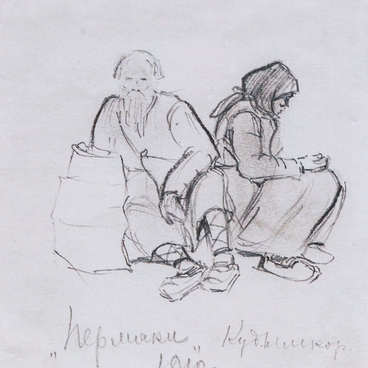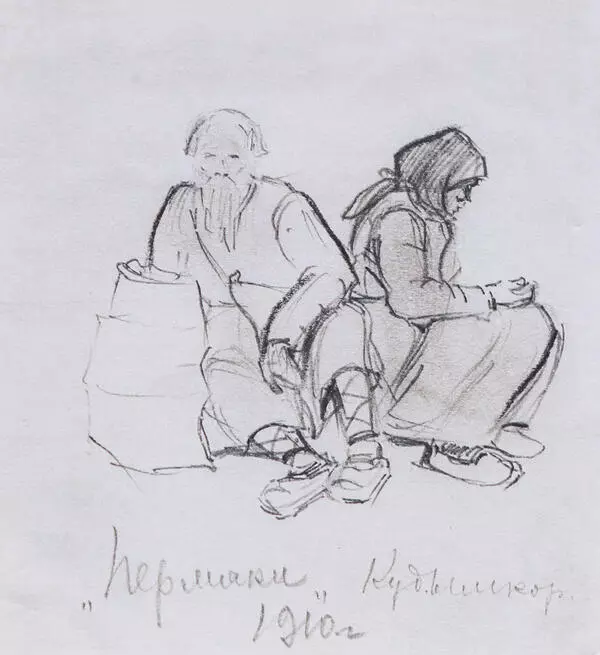The color scene drawing depicts four seated people of different ages. On the right is a woman with a child on her lap, wearing a white headscarf, blue vest, crimson skirt, white shirt with Komi-Permyak decorative pattern on the sleeve and the apron. On the child’s head is a round red cap, he is dressed in a blued shabur — a light homespun caftan. To the left is a man with a beard, wearing a brown zipun and a felted round hat. Behind him is a young man wearing a yellow brimmed hat, blue pants with white stripes, and holding a newspaper. The facial features are not traced clearly. In the 1920s, the artist’s wife, then head of the museum, donated the drawing.
One of the important subject matters in the work of Pyotr Ivanovich Subbotin-Permyak — the artist, who created the picture — is studying the ethnography of Komi-Permyaks: their everyday life, occupations, clothes, beliefs and traditional applied arts. The artist’s home village Kudymkar was a large settlement with log houses, vegetable gardens, fences, and carts. Pyotr Ivanovich was a great observer, he was interested in watching scenes in the streets, jetties; he was constantly in search of colorful characters and eye-catching costumes, it was easy for him to talk to people.
The drawing is part of the series of watercolor studies “Permyaks on the Jetty of Ust-Pozhva”, which consists of four scene drawings. These works are the best examples of the series “Komi Permyaks”, Subbotin-Permyak’s documentary heritage. In the portraits of Komi-Permyaks the artist was able to capture their anthropological type, character. He showed them at their main occupations, their urge to develop and learn. They are of special value owing to the color and the artist’s inscriptions.
Pyotr Ivanovich Subbotin-Permyak was the youngest of nine children in a peasant family. He graduated from the Stroganov Art and Industrial School in Moscow and laid the foundation for artistic education in the Kama region. Pyotr Ivanovich worked a lot in the art workshops that he founded in Perm, Kudymkar and Kungur, where he taught children different kinds of arts and crafts: printing on cloth, hand weaving, embroidery, woodcarving, artistic processing of bone and birch bark. Pyotr Ivanovich Subbotin-Permyak founded the Komi-Permyak Museum of Local History, which now bears his name. He died at the age of 36.
One of the important subject matters in the work of Pyotr Ivanovich Subbotin-Permyak — the artist, who created the picture — is studying the ethnography of Komi-Permyaks: their everyday life, occupations, clothes, beliefs and traditional applied arts. The artist’s home village Kudymkar was a large settlement with log houses, vegetable gardens, fences, and carts. Pyotr Ivanovich was a great observer, he was interested in watching scenes in the streets, jetties; he was constantly in search of colorful characters and eye-catching costumes, it was easy for him to talk to people.
The drawing is part of the series of watercolor studies “Permyaks on the Jetty of Ust-Pozhva”, which consists of four scene drawings. These works are the best examples of the series “Komi Permyaks”, Subbotin-Permyak’s documentary heritage. In the portraits of Komi-Permyaks the artist was able to capture their anthropological type, character. He showed them at their main occupations, their urge to develop and learn. They are of special value owing to the color and the artist’s inscriptions.
Pyotr Ivanovich Subbotin-Permyak was the youngest of nine children in a peasant family. He graduated from the Stroganov Art and Industrial School in Moscow and laid the foundation for artistic education in the Kama region. Pyotr Ivanovich worked a lot in the art workshops that he founded in Perm, Kudymkar and Kungur, where he taught children different kinds of arts and crafts: printing on cloth, hand weaving, embroidery, woodcarving, artistic processing of bone and birch bark. Pyotr Ivanovich Subbotin-Permyak founded the Komi-Permyak Museum of Local History, which now bears his name. He died at the age of 36.



